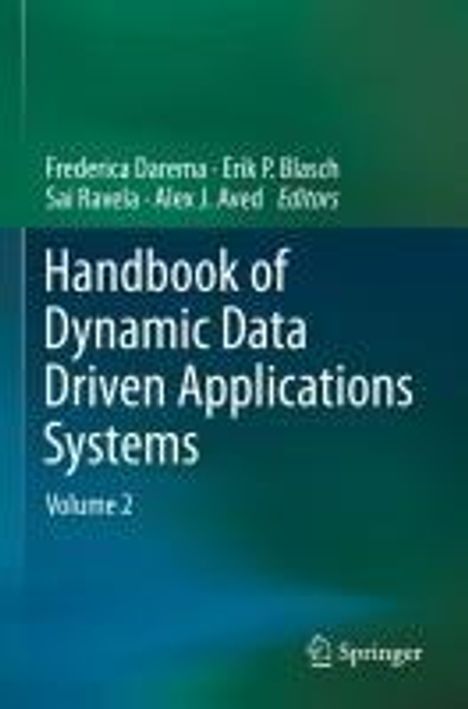Handbook of Dynamic Data Driven Applications Systems, Kartoniert / Broschiert
Handbook of Dynamic Data Driven Applications Systems
- Volume 2
(soweit verfügbar beim Lieferanten)
- Herausgeber:
- Frederica Darema, Erik P. Blasch, Sai Ravela, Alex J. Aved
- Verlag:
- Springer, 09/2024
- Einband:
- Kartoniert / Broschiert, Paperback
- Sprache:
- Englisch
- ISBN-13:
- 9783031279881
- Artikelnummer:
- 11971510
- Umfang:
- 968 Seiten
- Gewicht:
- 1434 g
- Maße:
- 235 x 155 mm
- Stärke:
- 52 mm
- Erscheinungstermin:
- 15.9.2024
- Hinweis
-
Achtung: Artikel ist nicht in deutscher Sprache!
Weitere Ausgaben von Handbook of Dynamic Data Driven Applications Systems |
Preis |
|---|
Klappentext
This Second Volume in the series Handbook of Dynamic Data Driven Applications Systems (DDDAS) expands the scope of the methods and the application areas presented in the first Volume and aims to provide additional and extended content of the increasing set of science and engineering advances for new capabilities enabled through DDDAS. The methods and examples of breakthroughs presented in the book series capture the DDDAS paradigm and its scientific and technological impact and benefits. The DDDAS paradigm and the ensuing DDDAS-based frameworks for systems' analysis and design have been shown to engender new and advanced capabilities for understanding, analysis, and management of engineered, natural, and societal systems ("applications systems"), and for the commensurate wide set of scientific and engineering fields and applications, as well as foundational areas. The DDDAS book series aims to be a reference source of many of the important research and development efforts conducted under the rubric of DDDAS, and to also inspire the broader communities of researchers and developers about the potential in their respective areas of interest, of the application and the exploitation of the DDDAS paradigm and the ensuing frameworks, through the examples and case studies presented, either within their own field or other fields of study. As in the first volume, the chapters in this book reflect research work conducted over the years starting in the 1990's to the present. Here, the theory and application content are considered for:
Foundational Methods
Materials Systems
Structural Systems
Energy Systems
Environmental Systems: Domain Assessment & Adverse Conditions / Wildfires
Surveillance Systems
Space Awareness Systems
Healthcare Systems
Decision Support Systems
Cyber Security Systems
Design of Computer Systems
The readers of this book series will benefit from DDDAS theory advances such as object estimation, information fusion, and sensor management. The increased interest in Artificial Intelligence (AI), Machine Learning and Neural Networks (NN) provides opportunities for DDDAS-based methods to show the key role DDDAS plays in enabling AI capabilities; address challenges that ML-alone does not, and also show how ML in combination with DDDAS-based methods can deliver the advanced capabilities sought; likewise, infusion of DDDAS-like approaches in NN-methods strengthens such methods. Moreover, the "DDDAS-based Digital Twin" or "Dynamic Digital Twin", goes beyond the traditional DT notion where the model and the physical system are viewed side-by-side in a static way, to a paradigm where the model dynamically interacts with the physical system through its instrumentation, (per the DDDAS feed-back control loop between model and instrumentation).


